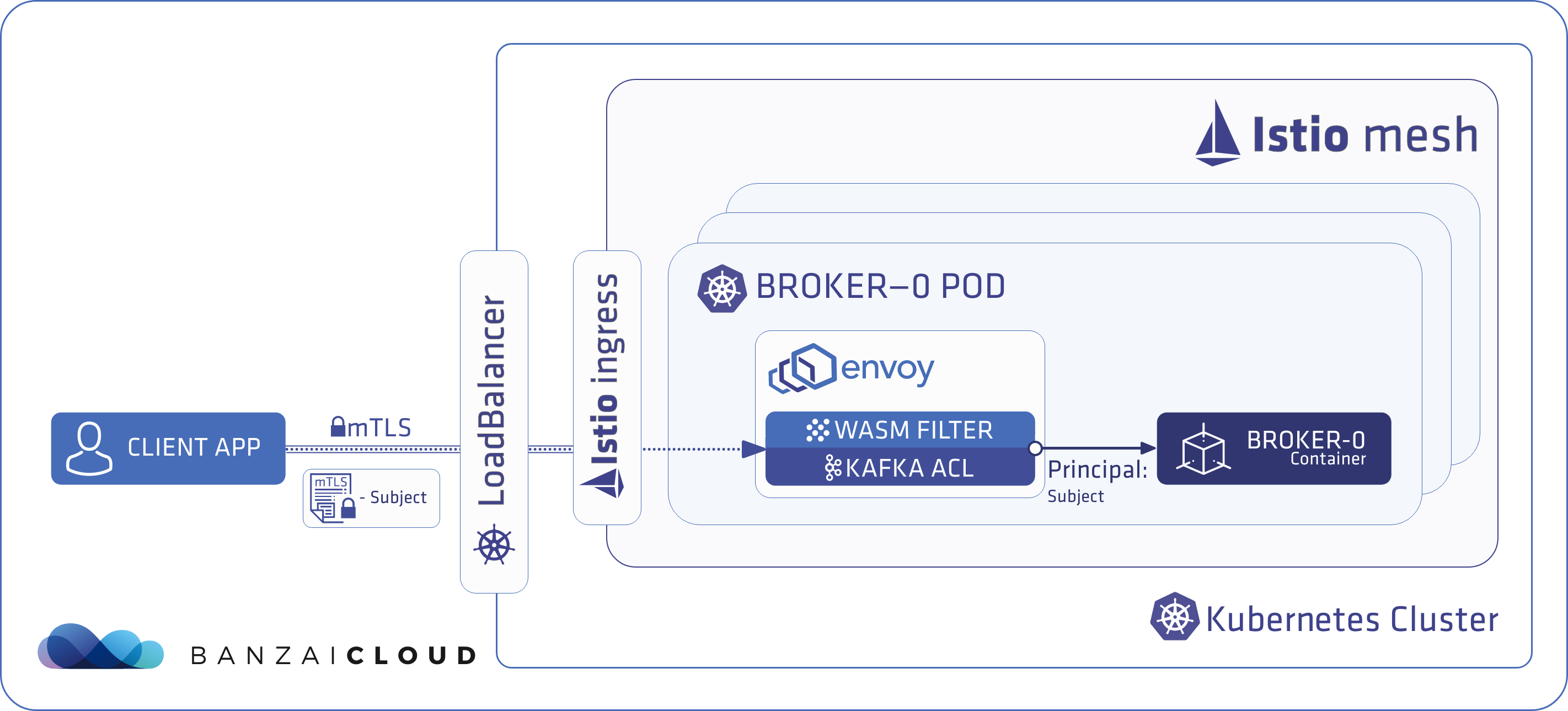This scenario covers using Kafka ACLs when your client applications are outside the Kubernetes cluster. As a result, the client applications must connect to the endpoint bound to the Kafka cluster’s external listener. In this scenario, the client applications must present a client certificate to authenticate themselves.

Prerequisites 🔗︎
To use Kafka ACLs with Istio mTLS, you need:
- a Kubernetes cluster (version 1.15 and above), with
- at least 8 vCPU and 12 GB of memory, and
- with the capability to provision LoadBalancer Kubernetes services.
- A Kafka cluster.
Steps 🔗︎
This procedure uses cert-manager to issue client certificates to represent the client application.
-
Enable ACLs and configure an external listener using Supertubes. Complete the following steps.
-
Verify that your deployed Kafka cluster is up and running:
supertubes cluster get --namespace <namespace-of-your-cluster> --kafka-cluster <name-of-your-kafka-cluster> --kubeconfig <path-to-kubeconfig-file>Expected output:
Namespace Name State Image Alerts Cruise Control Topic Status Rolling Upgrade Errors Rolling Upgrade Last Success kafka kafka ClusterRunning banzaicloud/kafka:2.13-2.5.0-bzc.1 0 CruiseControlTopicReady 0 -
Enable ACLs and configure an external listener. The deployed Kafka cluster has no ACLs, and external access is disabled by default. Enable them by applying the following changes:
supertubes cluster update --namespace kafka --kafka-cluster kafka --kubeconfig <path-to-kubeconfig-file> -f -<<EOF apiVersion: kafka.banzaicloud.io/v1beta1 kind: KafkaCluster spec: ingressController: "istioingress" istioIngressConfig: gatewayConfig: mode: PASSTHROUGH readOnlyConfig: | auto.create.topics.enable=false offsets.topic.replication.factor=2 authorizer.class.name=kafka.security.authorizer.AclAuthorizer allow.everyone.if.no.acl.found=false listenersConfig: externalListeners: - type: "plaintext" name: "external" externalStartingPort: 19090 containerPort: 9094 EOF -
The update in the previous step reconfigures the Kafka cluster to receive rolling updates. Verify that this is reflected in the state of the cluster.
supertubes cluster get --namespace kafka --kafka-cluster kafka --kubeconfig <path-to-kubeconfig-file>Expected output:
Namespace Name State Image Alerts Cruise Control Topic Status Rolling Upgrade Errors Rolling Upgrade Last Success kafka kafka ClusterRollingUpgrading banzaicloud/kafka:2.13-2.5.0-bzc.1 0 CruiseControlTopicReady 0 -
Wait until the reconfiguration is finished and the cluster is in the ClusterRunning state. This can take a while, as the rolling upgrade applies changes on a broker-by-broker basis.
-
-
Install and configure cert-manager for the client. Complete the following steps.
-
Connect to the cluster where your client application is running.
-
Install cert-manager on the cluster.
kubectl apply -f https://github.com/jetstack/cert-manager/releases/download/v0.14.2/cert-manager.yaml -
Specify a cluster issuer for cert-manager that has the same CA or root certificate as the Istio mesh, otherwise, the application’s client certificate won’t be valid for the mTLS enforced by Istio.
-
Get the CA certificate used by Istio:
kubectl get secrets -n istio-system istio-ca-secret -o yamlThis secret has different fields than what cert-manager expects.
-
Create a new secret from this in a format that works for cert-manager.
kubectl create -f - <<EOF apiVersion: v1 kind: Secret metadata: name: ca-key-pair namespace: cert-manager data: tls.crt: <tls-crt-from-istio-ca-secret> tls.key: <your-tls-key-from-istio-ca-secret> EOF kubectl create -f - <<EOF apiVersion: cert-manager.io/v1alpha2 kind: ClusterIssuer metadata: name: ca-issuer namespace: cert-manager spec: ca: secretName: ca-key-pair EOF
-
-
Create a Kafka user that the client application will use to identify itself. Grant this user access to the topics it needs.
kubectl create -f - <<EOF apiVersion: kafka.banzaicloud.io/v1alpha1 kind: KafkaUser metadata: name: external-kafkauser namespace: default spec: clusterRef: name: kafka namespace: kafka secretName: external-kafkauser-secret pkiBackendSpec: pkiBackend: "cert-manager" issuerRef: name: "ca-issuer" kind: "ClusterIssuer" topicGrants: - topicName: example-topic accessType: read - topicName: example-topic accessType: write EOF
-
-
Get the endpoint bound to the external listener of the Kafka cluster:
kubectl get svc -n kafka kafka-meshgatewayExample output:
NAME TYPE CLUSTER-IP EXTERNAL-IP PORT(S) kafka-meshgateway LoadBalancer 10.10.44.209 aff4c6887766440238fb19c381779eae-1599690198.eu-north-1.elb.amazonaws.com 19090:32480/TCP,19091:30972/TCP,29092:30748/TCP -
Export the client certificate stored in
external-kafkauser-secretwhich represents Kafka userexternal-kafkauser, and the CA certificate of Istio:kubectl get secret external-kafkauser-secret -o 'go-template={{index .data "ca.crt"}}' | base64 -D > /var/tmp/ca.crt kubectl get secret external-kafkauser-secret -o 'go-template={{index .data "tls.crt"}}' | base64 -D > /var/tmp/tls.crt kubectl get secret external-kafkauser-secret -o 'go-template={{index .data "tls.key"}}' | base64 -D > /var/tmp/tls.key -
Use the exported client credentials and the CA certificate in your application to connect to the external listener of the Kafka cluster. (Otherwise, Istio automatically rejects the client application.) The following command is an example to connect with the kafkacat client application:
kafkacat -L -b aff4c6887766440238fb19c381779eae-1599690198.eu-north-1.elb.amazonaws.com:29092 -X security.protocol=SSL -X ssl.key.location=/var/tmp/tls.key -X ssl.certificate.location=/var/tmp/tls.crt -X ssl.ca.location=/var/tmp/ca.crt Metadata for all topics (from broker -1: ssl://aff4c6887766440238fb19c381779eae-1599690198.eu-north-1.elb.amazonaws.com:29092/bootstrap): 2 brokers: broker 0 at aff4c6887766440238fb19c381779eae-1599690198.eu-north-1.elb.amazonaws.com:19090 (controller) broker 1 at aff4c6887766440238fb19c381779eae-1599690198.eu-north-1.elb.amazonaws.com:19091 1 topics: topic "example-topic" with 3 partitions: partition 0, leader 0, replicas: 0,1, isrs: 0,1 partition 1, leader 1, replicas: 1,0, isrs: 0,1 partition 2, leader 0, replicas: 0,1, isrs: 0,1












